Find out figure skating stretches routines to perform before and after practice, as well as outside the rink, in order to prevent injuries and improve performance. This should be an essential part of your training.
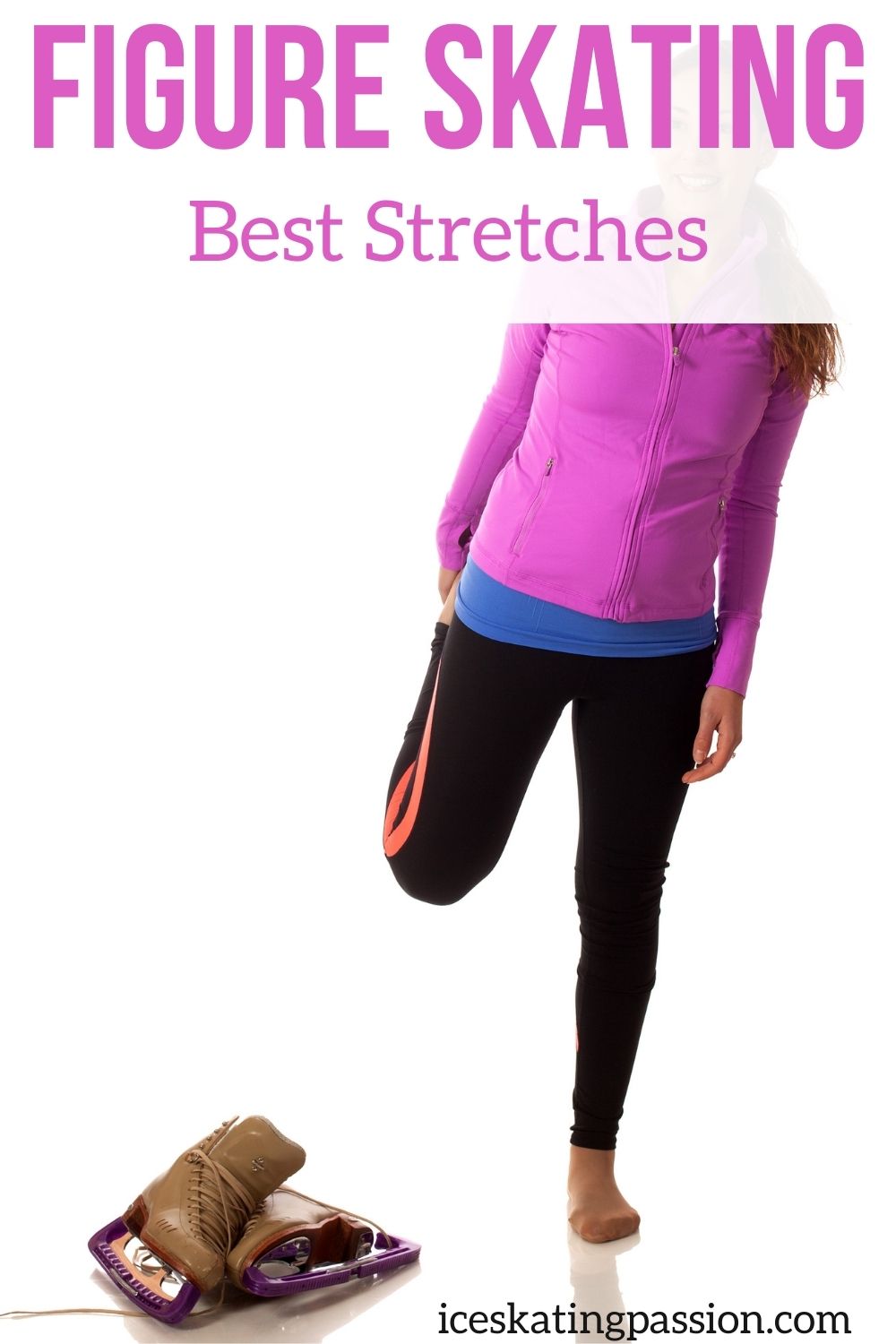
This article contains affiliate links. If you purchase using my link, I get a commission at no extra cost to you (learn more).
Stretching for figure skater - why, when, how
Why should a figure skater stretch?
Stretching is an essential part of every sport. Sadly, it is often the most overlooked. Some skaters, especially younger ones, don’t grasp the importance of warming up before ice skating practice or cooling down after.
A good stretching routine will:
- reduce muscle imbalances
- prevent injuries, such as pulled muscles or worse - If your muscles are tight when you’re performing a fast leg movement, for example, your muscles are more likely to snap.
- improve performances

Sasha Cohen Split jump, by Rich Moffitt from Boston, USA, CC BY 2.0
Essential to know before stretching
- Stretches should always be done on warm muscles. If done before training or during the day, start with five to ten minutes of movement that increases your body temperature and causes a light sweat, e.g. jogging or jumping jacks.
- Don't hold your breath! - It is essential to bring oxygen to the muscles and expulse carbon dioxide for a good stretch. Breathe slowly out as you lean into the stretch.
- Stretching should be pain-free - if it starts hurting, move back-off to the position where you don’t feel any more pain and hold it.
- When holding the position, you may start feeling ease in the muscle. Then, you can push the stretch a little further.
What muscles should ice skaters stretch?
Figure skaters use almost all the muscles - especially on jumps and spins, but even on simple steps. The whole body contributes to balancing on the little thin blade.
Even though the most important are your lower body stretches, do not overlook the upper body.
- Muscles of the legs: quadriceps, hamstrings, hip flexors, calves and achilles, groin, hip abductors, and hip adductors
- Muscles of the upper body: neck, shoulders, upper and lower back, chest, sides of torso
When should figure skaters stretches?
For figure skaters, stretches are required at 3 moments of your training for different objectives:
- During warm-up, before any ice skating training sessions - First do a general body warm-up and then do dynamic stretching (short quick movements) to prepare your muscles for the rapid contractions and prepare for some flexibility movements specific to your programs.
- Right after practice - when your muscles are still warm and you are cooling down, gradually decrease the pace and then perform static stretching (long slow holds) to improve overall flexibility and balance your muscles.
- During the week, off-ice training - if trying to improve flexibility for better performance, extra sessions of stretches are important. But stretches should always be done on warm muscles.
Exercises for all 3 stretching moments will be shared in the following sections of this article.
Important Note
The following recommendations are based on years of figure skating practice, recommendations by coaches and by physical therapists.
They are typical stretches for figure skaters, without special needs.
Before any physical activity, especially with a specific injury and difficulty, it is always recommended to consult your doctor or physical therapist to adapt to your individual needs.
And don't forget to hydrate!
Personalize your water bottle! See all my available designs and colors here.
Warm-up: 8 Dynamic Stretches before figure skating practices
Most warm-up exercises (apart from those to increase your heart rate) are dynamic stretches, which means moving through a range of motions, repeatedly but with control. The motion limits should be challenging but comfortable.
They are not often thought to be stretches, but since they force you to increase your range of motions compared to normal activities, it does stretch your muscles.
They are essential to improve your range of motions and mobility, thus preparing your muscles for what there is to come during figure skating practice.
Plan
- Before putting on your skates, get your heart rate up by doing some jogging or jumping jack.
- Then complete the routine of exercises below - keep control of your movements even if dynamic (do not throw yourself in every direction)
- Repeat movements (slower movements at the beginning, higher intensity at the end)
- Then put on your skates
- And redo some arm swings, side lunges and trunk rotations before getting on the ice
Dynamic stretches to warm-up
1. Arm Circles
- Stand up straight
- Make circles with your arm, keeping control of your shoulder
- Alternate circles from front to back and back to front
- Do both arms
2. Bended swings
- Spread your legs on the side
- Sand up straight with your arms at 90° on either side
- In a controlled manner, go and touch your opposite feet with your fingertips
- Alternate

3. Front lunges
- Stand up straight
- Move forward with one leg and bend to 90 degrees (the back leg bends as well)
- Push to stand back up
- Alternate legs

4. Side lunges
- Stand up straight
- Spread your legs to each side of your hips, stay centered
- Bend one leg to 90°
- Move back up to the middle
- Bend the other leg to 90°
- Move back up to the middle

5. Trunk rotations
- Stand up straight and spread your legs slightly to align with your hips
- Lift and bend your arms in front of your chest (but keep your shoulders down)
- Rotate left and right - make sure you control the movement, go as far as possible without triggering pain
6. Ankle rotations
- Stand up straight and spread your legs slightly to align with your hips
- Place your foot you its toes
- Rotate in both directions
- Alternate feet

7. Leg curls
- Finish with high intensity leg curls
- Alternate legs to bring heels to butt
- Alternate legs to lift knee to stomach level
8. Figure skating movements
- Simulate jumps
- Simulate landings
7 essential Post-Training figure skating stretches
Right after practice, when your muscles are still warm, you should complete this stretching routine every single time.
This is essential to balance your muscles and improve flexibility.
Those stretches are called static, because they are held in a challenging but comfortable position for a period of time without bouncing. You slowly take your muscles to the end of their range.
Because you are at the rink, all the following exercises can be done standing up and still with your skates on (but don't forget to put your blade guards on).
#1 Quadriceps stretches
Your quadriceps (front thighs) are powerful muscles. They are hard at work during figure skating practice.
- Stand straight (don't lean forward)
- Fold one leg behind you, and grab your foot with your hand on that side
- Keep your other leg straight and keep your knees as close as possible to each other
- Pull your heel gently toward your backside, feel the stretch in your quad.
- Hold the stretch for 20 to 30 seconds. Switch legs.
- Release and repeat 3 or 4 times.
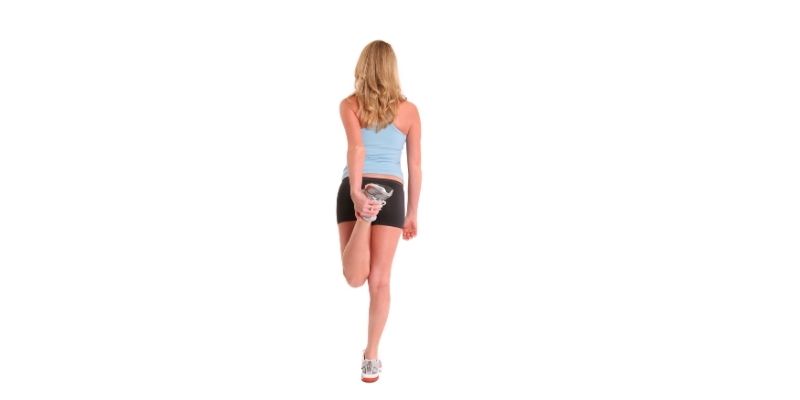
#2 Calf stretches
Figure skating is very demanding on calves. They must be systematically stretched.
- Stand in front of a wall or in front of the rink railing
- Stretch one leg behind you and bend the other - keep the distance the same as your hips
- Pull your heel gently toward the ground while bending the front leg
- Hold the stretch for 20 to 30 seconds.
- Release, switch leg and repeat 3 or 4 times.
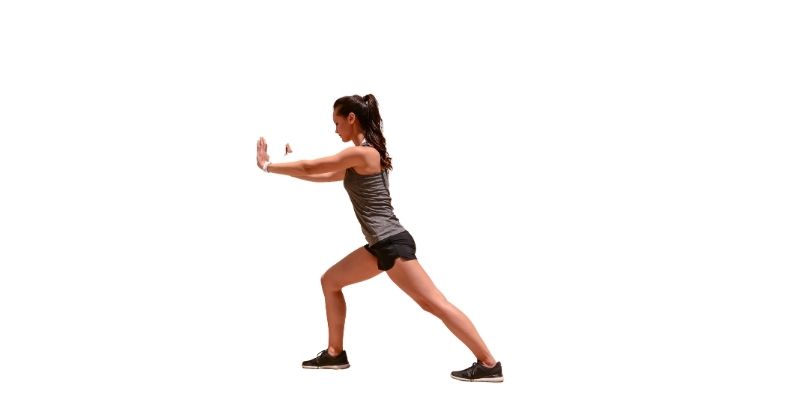
#3 Standing hamstring and back leg stretches
There are many positions good for stretching hamstrings.
Below are 3 different positions, choose the one that is the most efficient for you:
- Stand straight up
- Position 1 - Place your right leg in front of you. Bend your left knee (a little)
Position 2 - feet slightly spread apart under the hips
Position 3 - cross your right foot in front of your left foot, keep knees straight - You can place your hands on the most stable thigh (or both)
- Gently lean forward, keeping your back straight (no hunching!)
- Hold the stretch for 20 to 30 seconds.
- Release, switch leg and repeat 3 or 4 times.
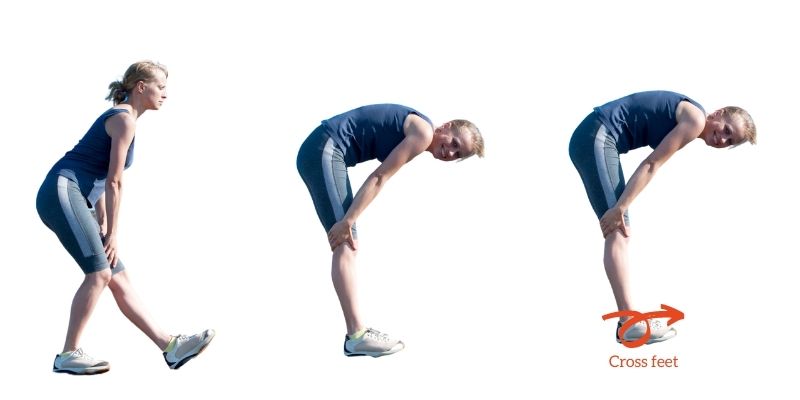
#4 Groin and inner thigh stretches
Lateral lunges are one of the easiest ways to stretch your adductors and inner thighs after practice while standing up.
- Take a wide lateral stance with your right foot
- Turn your right foot pointing 45 degrees outside
- Bend the right knee and lunge slightly to the right side
- You feel the thigh muscles of the straight left leg lengthen. It’s important not to bounce!
- Hold the stretch for 20 to 30 seconds.
- Release, switch leg and repeat 3 or 4 times.

#6 Back and abs stretch
With all the twists, contractions and impacts, your abs are hard at work to keep balance and momentum. This exercise allows you to stretch your side abdominals, obliques and also your arms.
- Stand straight up
- Feet slightly spread apart under the hips
- Cross your fingers, stretch your arms above your head - but make sure to DROP your shoulders away from your ears!
- Lean backward as far as you can without pain.
- Grab your left wrist with your right hand, and lean to the right as far as you can without pain.
- Grab your right wrist with your left hand, and lean to the left as far as you can without pain.
- Hold each stretch for 20 to 30 seconds.
- Release and repeat 3 or 4 times.

#6 & 7 Arms stretch
You use your upper body more than you think when figure skating. So, it needs to stretch too!
Stretch your triceps
- Bring one of your elbows across your body, towards your opposite shoulder.
- Use your other hand to bring your elbow closer to your shoulder.
- Hold for 20 to 30 seconds
- Release, switch arms and repeat 3 or 4 times.
Triceps and Shoulder Stretch
- Stand straight up, feet slightly spread apart under the hips
- Bring your right arm overhead and drop your forearm with your palm between your shoulder blades
- Your left hand grabs your elbow and pulls gently
- Keep your bicep close to your ear
- Hold for 20 to 30 seconds
- Release, switch arms and repeat 3 or 4 times.

Off-ice training - 6 flexibility stretching routine for figure skaters
The previous exercises are essential whatever your level, before and after practice.
But at a certain point in your figure skating, you may want to get more flexible to improve some of your skills.
In that case you need to work on a flexibility stretching routine outside the rink.
It should be part of a more complete off-ice training routine that includes:
- Balance
- Flexibility
- Explosiveness
- Endurance
- Grace and artistry
- Mental strength
- Rest
You can find my complete suggestions on my article about off-ice training.
Classic flexibility exercises
Many exercises can be done to improve flexibility using only your body weight
- Seated toe-touch stretches
- Cobra stretches
- Standing toe touch stretches
- Hip Flexor stretches
- Butterfly stretches
- Half splits and splits
You can also practice some of your figure skating attitudes while firmly on the ground.
This should be done at least once a week.
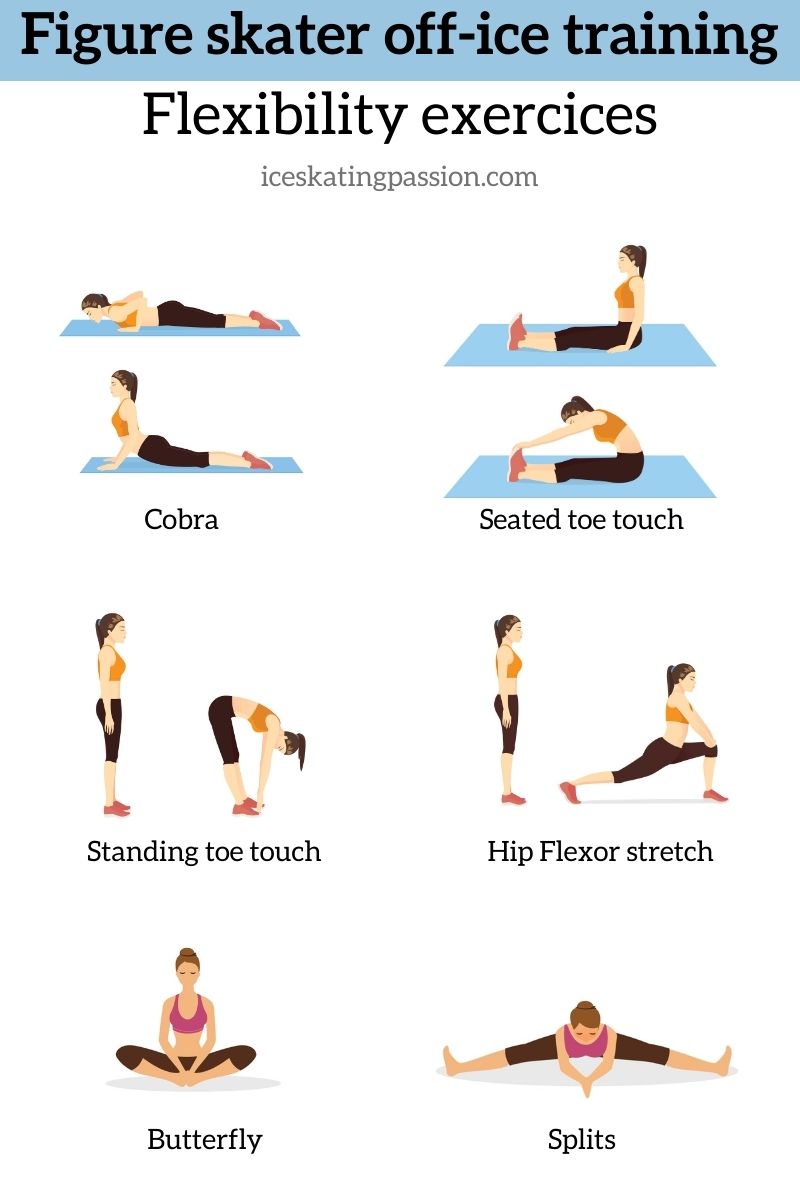
Make it fun with a personalized Yoga Mat! See all my available designs and colors here.
Flexibility training equipment
And if you want to reach even further, check out these off-ice training equipment pieces for flexibility:
You might also be interested in:





















